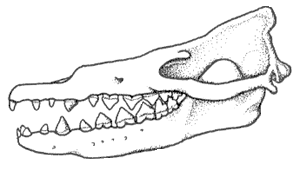Rodhocetus
|
|
| Rodhocetus | ||||||||||||
|---|---|---|---|---|---|---|---|---|---|---|---|---|
 A Rodhocetus skull | ||||||||||||
| Scientific classification | ||||||||||||
|
Rodhocetus is one of several extinct whale genera that possess land mammal characteristics, thus demonstrating the transition from land to sea that whales went through. The first species to be discovered (Rhodocetus kasrani) already exhibited such features as a large pelvis fused to the vertebrae, hind legs, and differentiated teeth. Of a recently discovered species (Rodhocetus balochistanensis), the ankle bones were recovered, further strengthening the already well-founded link to artiodactyls, but supposedly weakening the link to mesonychids.
Rodhocetus balochistanensis is in fact believed to demonstrate a direct evolutionary link to artiodactyls (modern examples of which are hippopotamuses and pigs). This has largely overturned previous fossil-based theories that whales were directly descended from mesonychids, though it matches studies of the genetic relations between whales and other animals.
The claim is based on the structure of the ankle bones of this species, which shows peculiarites known only in artiodactyls, and their ear bones, which are particularly like those of modern whales.
The first fossils of this species were found in Balochistan Province, Pakistan in 2001 by Philip Gingerich. Dating from about 47 million years ago, they are one of a series of recent discoveries, including the pakicetids, which have thrown considerable light on the previously mysterious evolutionary origin of whales.
See also
External links
- www.palaeos.com: Cetacea (http://www.palaeos.com/Vertebrates/Units/520Cetartiodactyla/520.100.html#Cetacea)de:Rodhocetus
